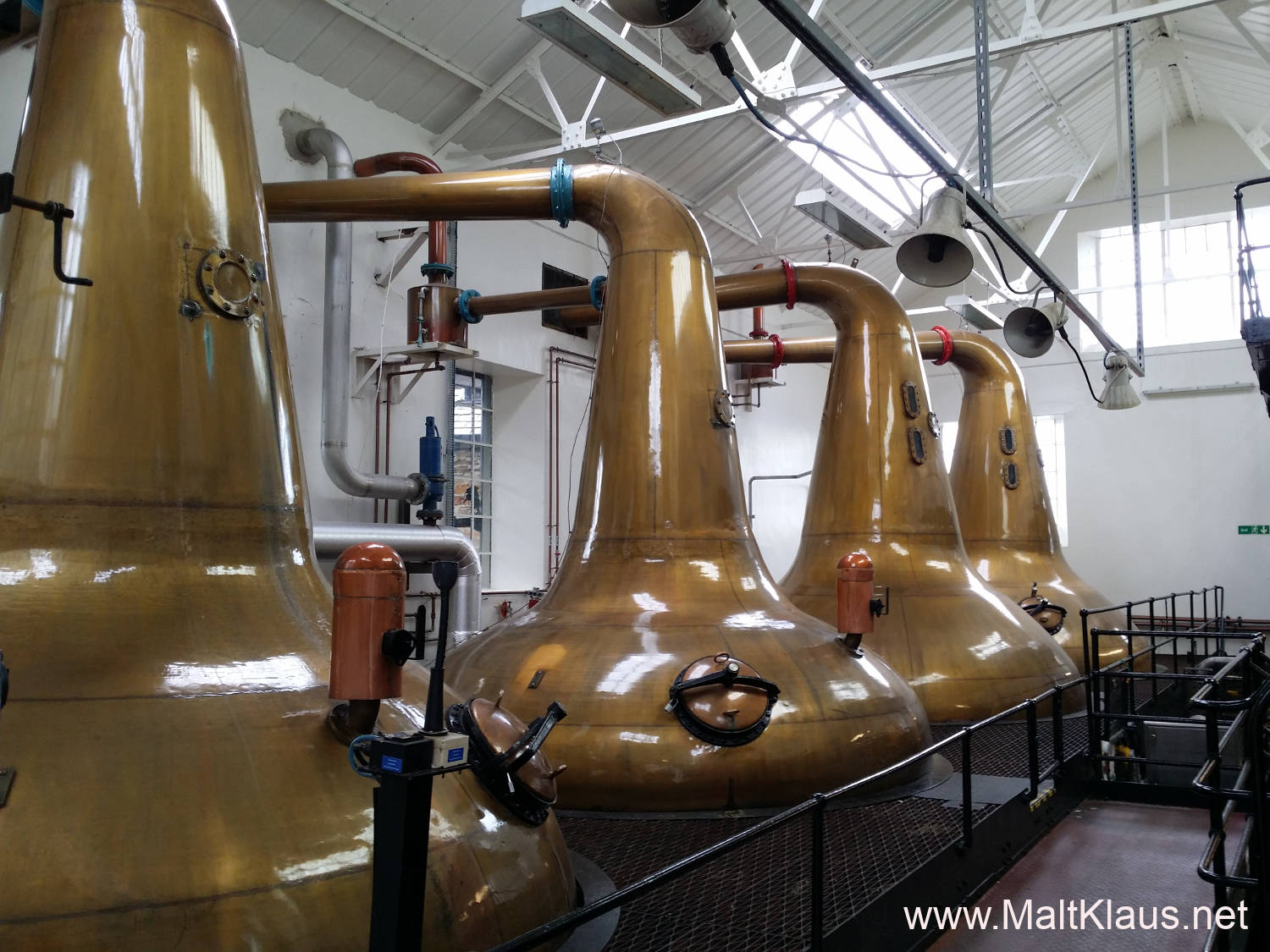Orkneys day 3
Preparing breakfast in the Kirkwall youth hostel (a cooked full-Scottish one, of course), Jo and I could already see the first destination for our last full day on the Orkneys in the distance: Up on the hill on the other side of Kirkwall, smoke emerged from the pagodas of the Highland Park distillery. Having heard many good stories from delighted visitors, this distillery was high up on my “bucket list” for a long time. Now, as some of you know, I’ve voiced my criticism about Highland Park before, especially concerning a few of the rather expensive and marketing-driven, “collectable” releases of the past years. A distillery almost hidden behind a thick layer of branding, like a veil. Marketing aside, the distillery produces a great distillate and by visiting I was hoping I would get to lift the veil, to see the “real” Highland Park. So, I was excited and ready to have my preconceptions shattered!
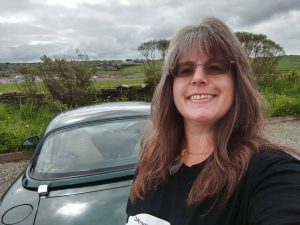
Highland Park distillery
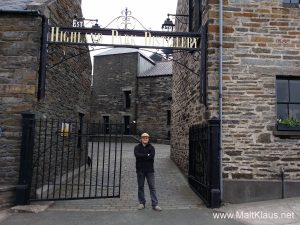
Upon striding through the iron gate bearing the distillery’s name, one can see the immaculate state the distillery is kept in. Impressive stone-wall buildings, flowers everywhere, the place is kept to impress, as is the stylish, dark, themed visitor’s centre. Thanks to an arrangement by Nicola (shout out!) we were set to go on a separate tour, led by Mark, joined by a visiting group of distributors. When you’re trying to get a feel for a place and get as much information as possible for an article, it’s always good to get the extra time for pictures, questions and sticking your nose into places and things. It also helps when the tour is held by a knowledgeable person, which Mark certainly turned out to be!
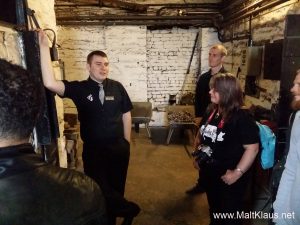
As it is common these days, the tour started with a short intro film, but that was about the only “standard” procedure, as we made our way to one of the dunnage warehouses on site for a wee warm-up dram. These days, most distilleries, especially ones on islands, don’t mature most of their whisky (or any whisky at all) on site, opting for more convenient storage on the mainland. The majority of Highland Park’s production, however, is stored on site on the island – about 80%, or 44.000 casks, to be exact, the rest maturing elsewhere due to insurance reasons (you don’t want to lose all you whisky in the case of a fire, right?). All of the whisky destined for single malt releases is matured on site – except for a few select casks of very old stock, which are kept in conditioned storage in Glasgow. The 19 traditional dunnage warehouses are accompanied by another four racked warehouses where the whisky is racked 7 high (for the geeks amongst you). Now, usually there are differences in temperature in the racked warehouses between the top and the bottom, but with the Orkneys being such a cool and chilly place all year round, it apparently doesn’t matter at all. The cool climate also keeps the angel’s share down (the amount of whisky lost from the casks due to evaporation) – at about 0,5% on average per year, which is really low. Most distilleries quote a loss of about 2% per year. So what type of casks is the whisky matured in? Ex-Sherry casks, for the most part, which are produced in Spain to specification for Edrington, which apparently costs them about 25 million pounds per year (for all their distilleries, including the Macallan). Bourbon casks, such as for the Highland Park Ice edition, are the minority, but we heard there are more bourbon-only releases coming.

Right, so we’ve heard all about maturation – time to take a look at how the spirit is produced! Highland Park is one of just a handful of distilleries to still use their own floor maltings. After steeping the barley in water, it is spread out on the malt floor and left to germinate for six days, requiring turning every eight hours. After that, it’s transferred to one of the two kilns, first getting smoked over a peat fire to impart the smokiness, then dried over coke. I’ve wondered for a long time, how they kept things consistent, with the “homemade” malt certainly differing from what is bought in. The answer in the case of this Orkney distillery is rather simple: The malt they produce on site is heavily peated to about 40 ppm, using locally cut peat from the Hobbister moor. The malt they buy in from Simpsons is unpeated, and the two are mixed together. It used to be 20% floor malted barley, but through recent technological upgrades (improved firing), they could improve the ppm in the malt which allowed to cut that percentage down to 10%. Without a change in the only very lightly peaty distillate character, apparently.
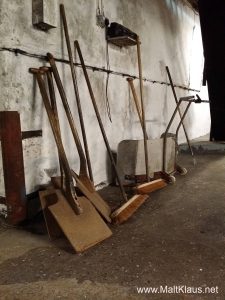
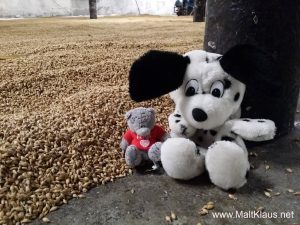
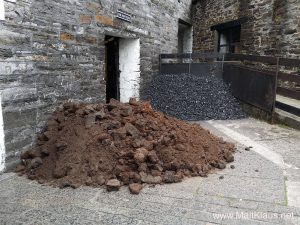
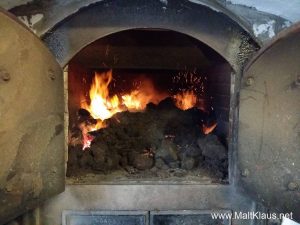
After malting (and mixing) it’s off to mashing and fermentation. Mashing at Highland Park is fairly regular in a stainless steel, closed mash tun, producing 29200 litres of wort, which gets pumped into one of the 12 wooden washbacks for fermenting. That’s when things get interesting. Utilising two different yeast strains, the wort ferments for about 70-100 hours, which is a very long time, helping to get fruity notes. A maxed-out distillery running at full steam would only ferment for 55-60 hours, but things don’t seem to get rushed here on the Orkneys, which is always a good thing. At the time of our visit (late May 2017) the distillery was “only” working a 5,5-day per week production schedule, which means a production of about 1,9 million litres of pure alcohol per year, with a theoretical maximum of 2,5 million litres per year. Cutting back from 24/7 production is not unusual and I’ve been increasingly hearing the same story for the past two years at a number of distilleries. With several brands of blended whisky seeing a decrease in sales, less young(ish) malt whisky volume is needed, with shortages mostly occurring in the older vintages for premium blends and single malts. Anyway, I digress, where were we? Oh, yes, off to the still house!
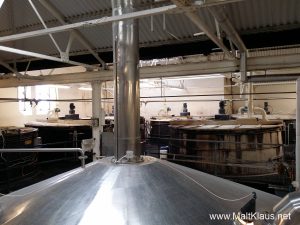
Highland Park has two pairs of rather dumpy, pear-shaped stills sitting in the still house across the courtyard from the mash house. You’ve got to look closely to tell the wash and spirit stills apart – they look very similar. (Hint: The wash stills have viewing ports). The heart cut (the spirit that makes it into the casks), has a rather narrow cut, with a longer foreshot run than many other distilleries. Other than that it’s traditional double distillation and my notes on that are rather short, in part because the group was eager to head into the tasting room – after a second detour to the warehouses.

After over two hours on our feet touring the distillery, it was time for a liquid lunch (for the designated drinker – me) in the very comfy tasting room. The party of distributors was already running late, but still, there was no rush and we had ample time to nose, taste and compare the flight of no less than seven drams. You know you are amongst professionals when you see nobody necking all of them. Mark did a great job – everybody at the table had been to many tastings before, so instead of giving us the usual “tasting experience”, it was much more a conversation about the drams between everybody involved. Oh, the drams? Besides the travel retail “Leif Eriksson” bottling (which I found a bit light and nondescript) we tasted the entire core range, starting with the 12yo, the 18yo, 21yo, 25yo, 30yo and, yes, the 40yo. I have taken away the 21, 25, 30 and 40 in sample bottles, so this will be a vertical tasting feature on the blog in the future. In a nutshell, I would say this: The 12yo held up very favourably in direct comparison (I’ve had batches which tasted rather light and a tad simple). The 18yo stood out as a staple dram, although it has “advanced” considerably in price in recent years. The 25 and 30 yo really stood out (I don’t remember my preference), and I’m a bit sorry to say I was a bit disappointed of the 40 yo. It was good, but not distinctive enough and paled in direct comparison to the 25 and 30, which were much more vibrant and expressive. Speaking of bottlings: All of the HP releases are uncoloured and for what it’s worth there’s only a very mild chill filtration applied (for the geeks: at +4°C instead of the usual -4°C).
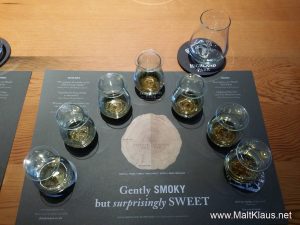
All in all both Jo and I had our expectations exceeded. It fascinates me how you perceive a distillery to be from what the “brand image” wants you to believe, and how it really is when you visit. At its heart, it is a hard-working, beautifully maintained, small to mid-scale island distillery producing a great spirit, which only gets its eccentric and sometimes quite elitist image by the doing of the marketing department and the very high pricing of the older expressions – which is a shame, because the “mid range” is truly good stuff, just not accessible for us normal punters. Well, there’s not much I can do about that, but I will continue to pick up the odd bottle of the 18 year-old (when, ahem, I see it on offer).
Thanks a lot, Mark, for the very “un-branded”, in-depth and no-BS look behind the scenes and behind the “brand mask” of the beautiful HIghland Park distillery, and thanks again to Nicola for arranging the visit.
3,5 hours after entering the gates, we left, with a huge smile on our faces and a grumbling stomach, so time to hunt down something to eat!
Tour de breweries
Where do you go when you’ve just toured a distillery and are hungry? A brewery, of course! Beer is liquid bread, as we say in my neck of the woods. The stylish tap room at the Orkney brewery not only allows you to sample their beers, you can also grab a bite to eat. A pint (Norseman Pale Ale) and haggis nachos worked a treat! Instead of hanging around, the next decision was to make a mad dash towards the second brewery on the island – Swannay. Yep, we made it in time before closing and acquired a few more bottles which I was already stacking up behind the seat in Jo’s Mazda sports car called “Maizy” due to, err, overflowing baggage!

Kirbuster museum
On our way to Swannay brewery we had passed by a wee museum which looked interesting, so that was our next destination. We hadn’t been to any other museum or cultural establishment so far (apart from the standing stones and dig site at Skara Brae), so it was about high time to do something about that. Kirbuster museum is “the last un-restored example of a traditional ‘firehoose’ in Northern Europe”, occupied until the 1960s. Walking through the different buildings, looking at the photographs, the tools and the way of life had a profound effect on both Jo and myself. It’s one thing to just look at artefacts at a modern museum, but another to walk through an almost untouched house, smelling the lit peat fire and just taking it all in. It’s hard to imagine just how tough life out here on a windswept island must have been in simpler times, but this museum does a very good job at giving you a feel for that. Highly recommended if you happen to visit Orkney!

The last evening
Two days are not enough to even see a small fraction of what Mainland has to offer, let alone all the other islands on the Orkneys. Still, the two full days we had spent there made us lust for more and returning hopefully soon – so much more to explore and witness. A home-cooked haggis and fresh local beer back at the youth hostel followed by a dram or two was the right way to talk about what we had experienced – and looking forward to the adventures ahead of us!
Onwards and upwards
The next day – and a glorious day at that, sunshine and all! – we had to leave the Orkneys, taking the ferry back the way we came – this time on the short route past the Old man of Hoy, in a rather rough sea. Today’s destination was Wishaw, in the central belt between Glasgow and Edinburgh, which is quite a bit of a drive – but a beautiful one, especially down to Inverness. The only major pit stop we made along the way was to pop by Clynelish, where we were kindly offered a free dram and had a look around the site of the old Brora distillery.
Arriving rather late that evening at Wishaw, the planned dinner at the Artisan restaurant was out of the picture. No matter, we would return the following day, which would also see us tour the site of the future Lindores Abbey distillery as well as meet the folks at Eden Mill St. Andrews. But that’s a story for next time!

Compliance notice: We toured Highland Park distillery by invitation from Edrington (thanks a lot, Nicola!), with full editorial control over the article retained and travel expenses paid for by myself.


